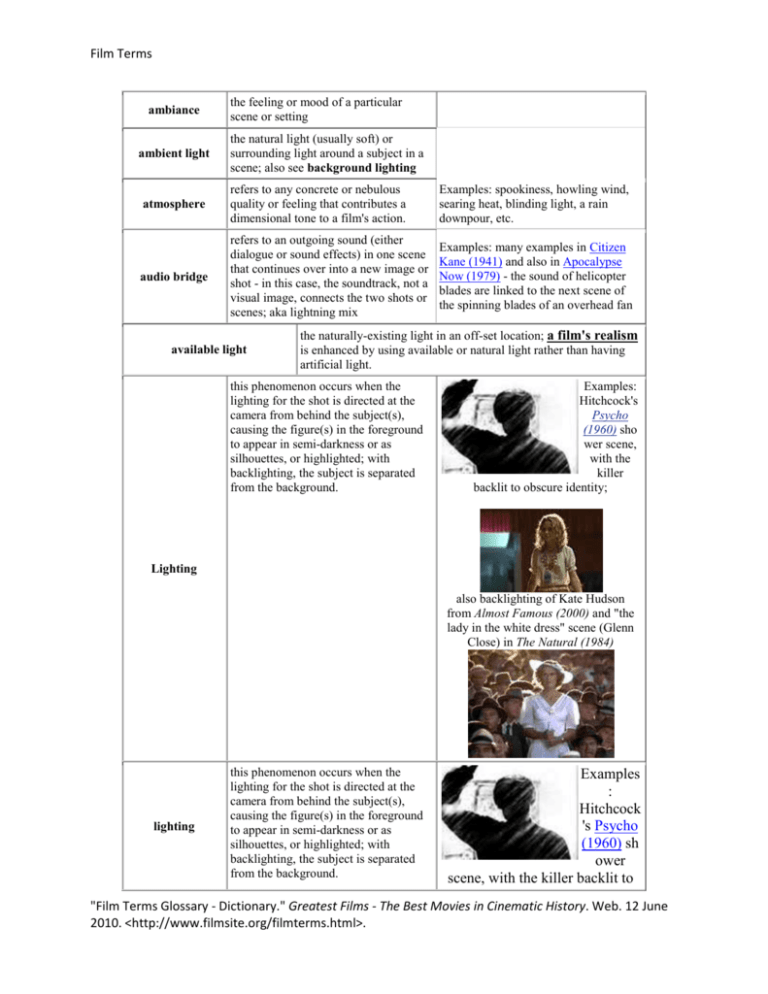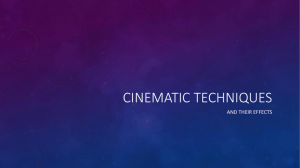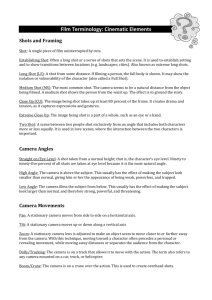Film Terms ambiance the feeling or mood of a particular scene or
advertisement

Film Terms
ambiance
ambient light
the feeling or mood of a particular
scene or setting
the natural light (usually soft) or
surrounding light around a subject in a
scene; also see background lighting
atmosphere
refers to any concrete or nebulous
quality or feeling that contributes a
dimensional tone to a film's action.
Examples: spookiness, howling wind,
searing heat, blinding light, a rain
downpour, etc.
audio bridge
refers to an outgoing sound (either
dialogue or sound effects) in one scene
that continues over into a new image or
shot - in this case, the soundtrack, not a
visual image, connects the two shots or
scenes; aka lightning mix
Examples: many examples in Citizen
Kane (1941) and also in Apocalypse
Now (1979) - the sound of helicopter
blades are linked to the next scene of
the spinning blades of an overhead fan
available light
the naturally-existing light in an off-set location; a film's realism
is enhanced by using available or natural light rather than having
artificial light.
this phenomenon occurs when the
lighting for the shot is directed at the
camera from behind the subject(s),
causing the figure(s) in the foreground
to appear in semi-darkness or as
silhouettes, or highlighted; with
backlighting, the subject is separated
from the background.
Examples:
Hitchcock's
Psycho
(1960) sho
wer scene,
with the
killer
backlit to obscure identity;
Lighting
also backlighting of Kate Hudson
from Almost Famous (2000) and "the
lady in the white dress" scene (Glenn
Close) in The Natural (1984)
lighting
this phenomenon occurs when the
lighting for the shot is directed at the
camera from behind the subject(s),
causing the figure(s) in the foreground
to appear in semi-darkness or as
silhouettes, or highlighted; with
backlighting, the subject is separated
from the background.
Examples
:
Hitchcock
's Psycho
(1960) sh
ower
scene, with the killer backlit to
"Film Terms Glossary - Dictionary." Greatest Films - The Best Movies in Cinematic History. Web. 12 June
2010. <http://www.filmsite.org/filmterms.html>.
Film Terms
obscure identity;
also backlighting of Kate
Hudson from Almost Famous
(2000) and "the lady in the white
dress" scene (Glenn Close)
in The Natural (1984)
camera angle
camera
movement
the point of view (POV) or perspective
(including relative height or direction)
chosen from which to photograph a
subject. Various camera angles,
compositions, or positions include:
front, behind, side, top, high (looking
down), low (looking up), straight-on or
eye-level (standard or neutral angle),
tilted (canted or oblique), or subjective,
etc.; see also framing
Example: Extreme camera
angles can be found in The Third
Man (1949).
the use of the camera to obtain various
camera angles and perspectives. (See
motion picture camera shots below,
including the pan, tilt, track, and zoom;
alsoboom/crane shots, Steadicam,
or hand-held)
Example: a camera on a dolly
track while filming a scene
from Raiders of the Lost Ark
(1981)
close-up
(CU)
a shot taken from a close distance in
which the scale of the object is
magnified, appears relatively large and
fills the entire frame to focus attention
and emphasize its importance; i.e., a
person's head from the shoulders or
neck up is a commonly-filmed closeup; a tight shot makes the subject fill
almost the entire frame; also extreme
close-up (ECU or XCU) is a shot of a
Examples: an extreme close-up
or tight shot from
Hitchcock's Psycho (1960)
"Film Terms Glossary - Dictionary." Greatest Films - The Best Movies in Cinematic History. Web. 12 June
2010. <http://www.filmsite.org/filmterms.html>.
Film Terms
part of a character (e.g., face, head,
hands) to emphasize detail; also known
as detail shot or close on; contrast
tolong-shot (LS)
and a closeup of Becky Driscoll's
(Dana Wynter) face, after Miles
(Kevin McCarthy) gives her
apathetic lips a kiss, and realizes
that she is "one of them"
inInvasion of the Body Snatchers
(1956)
composition
refers to the arrangement of different
elements (i.e., colors, shapes, figures,
lines, movement, and lighting) within a
frame and in a scene
Exampl
e: the
clever
composi
tion of
frames
inThe Sixth Sense (1999).
continuity
(editing or
cutting)
the system of editing that developed in
the early 20th century to provide a
continuous and clear movement of
events/images in a film; refers to the
final edited structure of a completed
film, with the events or
scenes/sequences arranged as if they
had occurred continuously, when, in
fact, they were shot out of sequence;
continuity also refers to the degree to
which a film is self-consistent without
errors, jump cuts, or mis-matched shots
and details; a continuity cut refers to a
editing cut that takes the viewer
seamlessly, unobtrusively, and logically
from one sequence or scene to another,
to propel the narrative along;
ablooper or flub is a continuity error
Exampl
e: Error
in
continui
ty
in Pretty Woman (1990) during
the breakfast scene, in which
Julia Roberts is first eating a
croissant that quickly switches to
a pancake; or the view of a gas
cartridge on a Roman chariot
inGladiator (2000).
cross-cutting
the editing technique of alternating,
interweaving, or interspersing one
narrative action (scene, sequence, or
event) with another - usually in
different locations or places, thus
combining the two; this editing method
suggests parallel action (that takes place
simultaneously); often used to
dramatically build tension and suspense
in chase scenes, or to compare two
different scenes; also known as intercutting or parallel editing.
Examples:
Porter's The Great
Train Robbery
(1903), D. W.
Griffith's The
Birth of a Nation
(1915) and the
finale of
Griffith'sIntolerance (1916),
where the chase to save the
"Film Terms Glossary - Dictionary." Greatest Films - The Best Movies in Cinematic History. Web. 12 June
2010. <http://www.filmsite.org/filmterms.html>.
Film Terms
pardoned hero from execution in
the modern story is cross cut
with Christ's procession to
Calgary; also the scene inThe
Godfather (1972), where the
baptism of Michael Corleone's
godson is cross cut with the
violent elimination of Corleone's
multiple underworld rivals.
diffusion
the reduction or softening of the
harshness or intensity of light achieved
by using a diffuser or translucent sheet
(lace or silk) in front of the light to cut
down shadows; materials include
screen, glass, filters, gauze, wire mesh,
or smoke; also see soft-focus.
direct sound
the technique of recording sound
simultaneously with the image
dolly (shot)
refers to a moving shot in which the
perspective of the subject and
background is changed; the shot is
taken from a camera that is mounted on
a hydraulically-powered wheeled
camera platform (sometimes referred to
as atruck or dolly), pushed on rails
(special tracks) and moved smoothly
and noiselessly during filming while the
camera is running; a pull-back
shot (or dolly out) is the moving back
('tracking back') of the camera from a
scene to reveal a character or object that
was previously out of the frame,dolly
in is when the camera moves closer
('tracking in') towards the subject,
and dollying along with (or 'tracking
within') refers to the camera moving
beside the subject; also known
as tracking shot, trucking shot, follow
shot, or traveling shot; contrast
with zoom shots.
focus
refers to the degree of sharpness or
distinctness of an image (or an element
of an image such as a person, object,
etc.); as a verb, it refers to the
manipulation or adjustment of the lens
to create a sharper image; terms related
are deep focus, shallow focus (very
common inclose-ups), soft focus,
and rack focusing
Example
s: the
first eight
minutes
of Robert
Altman's
The
Player (1992) was filmed with a
sustained dolly shot, similar to
the famous opening sequence
(shown here) of Welles' Touch
of Evil (1958); or the opening
shot in Boogie Nights (1997)that
tracked into the 70s disco, or the
shot from the dressing room to
the ring in Raging Bull (1980)
"Film Terms Glossary - Dictionary." Greatest Films - The Best Movies in Cinematic History. Web. 12 June
2010. <http://www.filmsite.org/filmterms.html>.
Film Terms
Examp
le:
lowkey
lightin
g in the film-noirish Touch of
Evil
key light
the main or primary light on a subject,
often angled and off-center (or from
above) that selectively illuminates
various prominent features of the image
to produce depth, shadows, etc.; highkey lighting (with everything evenly
and brightly lit, with a minimum of
shadows) is termed realistic (and often
used in musicals and comedies),
whilelow-key lighting (with less
illumination, more shadows, and many
grayish, dark areas) is termed
expressionistic (and often used in film
noir); three-point lighting uses: (1)
a fill (or filler) light - an auxiliary light
to soften shadows and areas not
covered by the key light, (2) aback
light behind to add depth to a subject,
and (3) a bright key light
long-shot
(LS)
a camera view of an object or character
from a considerable distance so that it
appears relatively small in the frame,
e.g., a person standing in a crowd of
people or a horse in a vast landscape;
variations are the medium long-shot (or
mid-shot) (MS) and the extreme longshot(ELS or XLS); also called a wide
shot; a long shot often serves as
an establishing shot; contrast to closeup(CU); a full-shot is a type of long
shot that includes a subject's entire
body (head to feet).
Examp
le: an
extrem
e longshot,
Ethan
Edwards (John Wayne) arriving
on horseback, in John Ford's The
Searchers (1958)
a French word literally meaning
"editing", "putting together" or
"assembling shots"; refers to a filming
technique, editing style, or form of
movie collage consisting of a series of
short shots or images that are rapidly
put together into a coherent sequence to
create a composite picture, or to suggest
meaning or a larger idea; in simple
terms, the structure of editing within a
film; a montage is usually not
accompanied with
dialogue; dissolves, cuts, fades, superimpositions, and wipes are often used to
link the images in a montage sequence;
an accelerated montage is composed of
shots of increasingly-shorter lengths;
contrast to mise-en-scene
Example
s: the
famous
'breakfast
' montage
scene
inCitizen
Kane (1941) - that dramatized
the deterioration of Kane's first
marriage; the ambush scene
in Bonnie and Clyde (1967), the
45 second shower scene
in Psycho (1960) - with between
71-78 camera set-ups for the
shooting of the scene and
50 splices (where two pieces of
film are joined); or the 'Odessa
Steps' montage in Sergei
montage
"Film Terms Glossary - Dictionary." Greatest Films - The Best Movies in Cinematic History. Web. 12 June
2010. <http://www.filmsite.org/filmterms.html>.
Film Terms
Eisenstein's Battleship Potemkin
(1925) including three
successive shots of stone lions in
various positions - filmed to look
as though they were one lion
rising to its feet and roaring in
fury and anger at the massacre
motivated and
unmotivated
lighting
overexposed
refers to lighting (or a light source) that
is naturally existing in the real world,
i.e., from a lamp post, table lamp,
sunlight shining through a window,
etc., that appears in a scene; for the
lighting to appear natural in a film
scene, it should seem to be coming
from light sources that are visible or
implied within the scene; the opposite
effect is unmotivated lighting
Exampl
e:
Andy's
crucifix
ion
victory stance in The Shawshank
Redemption (1994) was lit by
unmotivated or inexplicable
lighting
refers to a film shot that has more light
than normal, causing a blinding,
washed-out, whitish, glaring effect;
deliberately used for flashbacked or
dream scenes; aka flared or bleached;
the opposite of underexposed
Exampl
e: the
kissing
scene
in Pride
&
Prejudice (2005) before a bright
sun
a very commonly-used medium camera
angle or view in a dialogue scene,
mostly with alternating shot/reverseshotediting, in which the camera
over-the-shoulder records the action from behind the
shoulder and/or head of one of the
(OTS) shot
characters, thus framing the image; the
two characters are thus linked or
connected to each other, and their
positions are established
abbreviation for panorama shot; refers
to the horizontal scan, movement,
rotation or turning of the camera in one
direction (to the right or left) around a
fixed axis while filming; a variation is
the swish pan (also known as flash
pan
(or panning shot, pan, flick pan, zip pan,blur pan, or whip
pan), in which the camera is purposely
orpanoramic
panned in either direction at a very fast
shot)
pace, creating the impression of a fastmoving horizontal blurring of images
across the screen; often confused with
a dolly or tracking shot.
Examples:
the call to
roundup as
the camera
moves
around and
captures the faces of the
cowpokes inRed River (1948); in
John Ford's Stagecoach (1939) a
panning shot reveals the
presence of Indians just as the
stagecoach seems to be heading
"Film Terms Glossary - Dictionary." Greatest Films - The Best Movies in Cinematic History. Web. 12 June
2010. <http://www.filmsite.org/filmterms.html>.
Film Terms
to safety; and many films
utilizing the swish pan -- a fast
blurring panning action that
blends two scenes together
(signifying rapid movement from
one place to the next).
reaction shot
a quick shot that records a character's or group's response to another
character or some on-screen action or event; often accompanied with
a POV shot; reaction shots are usuallycutaways.
a basic camera angle composed of a shot
photographed from the opposite side of a
subject to provide a different perspective;
in a dialogue scene between characters, a
shot of the second participant is
commonly composed as an over-theshoulder shot; sometimes known as
an 180 degree angle shot or change in
reverse angle shot perspective; the alternating pattern
between two characters' points of view is
known asshot/reverse shot
Example: a typical dialogue scene
with shot/reverse shot between two
characters in Written on the Wind
(1956).
refers to a camera rotation - which can be a vertical or
horizontal pan; or it may refer to a camera move in which the
camera is moved in a complete (or half) circle to produce a spinning,
disorienting effect to the viewer; a partial rotation is termed a tilt
rotation
shot, scene, and sequence
a shot, scene, and sequence together make up the larger dramatic
narrative of film; scenes are composed of shots, sequences are
composed of scenes, and films are composed of sequences.
synchronous
sound
refers to sound whose source can be
seen in the image's frame, or whose
source can be understood from the
context of the image
theme music
the opening or closing music of a
motion picture, often containing the
film's 'signature'
or leitmotif tune/phrase that is
associated with a character or situation
within the film
three-shot
tone
Examples: 'Laura's theme' in Laura
(1944), John Williams' shark music
in Jaws (1975).
refers to a medium shot that contains
three people; compare to two-shot
the mood or atmosphere of a film
scene, often revealed by the director in
the way a film is directed, e.g., serious,
humorous, satiric, amusing, etc.
"Film Terms Glossary - Dictionary." Greatest Films - The Best Movies in Cinematic History. Web. 12 June
2010. <http://www.filmsite.org/filmterms.html>.
Film Terms
underexposed
zoom shot
refers to a film shot that has less light
than normal, causing an indistinct,
dimly-lit, unclear image; the opposite
of overexposed
a single shot taken with a lens that has a
variable focal length, thereby
permitting the cinematographer to
change the distance between the camera
and the object being filmed, and rapidly
move from a wide-angle shot to a
telephoto shot in one continuous
movement; this camera technique
makes an object in the frame appear
larger; movement towards a subject to
magnify it is known aszoom
in or forward zoom, or reversed to
reduce its size is known as zoom
out/back or backward zoom
Exam
ple:
Hitchc
ock's
muchimitat
ed and
unsettling Hitchcock-zoom(or contrazoom) in Vertigo (1958) using a
combination zoom in and dolly back,
resulting in a dramatic change in
perspective; the camera tracked in one
direction while zooming in the opposite
direction, causing an apparent
"lengthening" of distance down the
stairway
"Film Terms Glossary - Dictionary." Greatest Films - The Best Movies in Cinematic History. Web. 12 June
2010. <http://www.filmsite.org/filmterms.html>.




